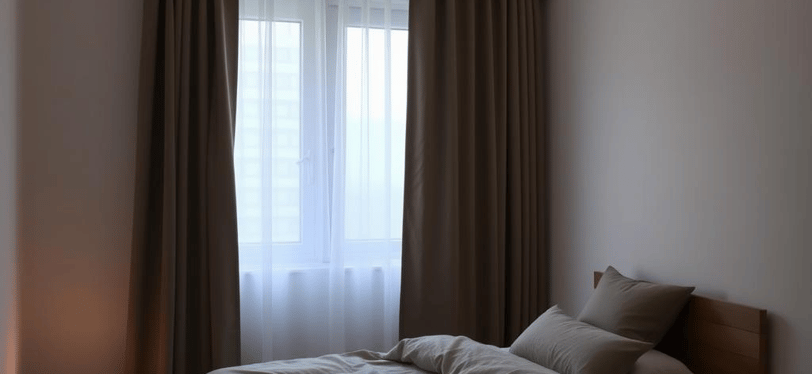Keep Your Bedroom Cool & Dark: Creating the Perfect Sleep Environment
🧘WELLNESS TIPS✨SELF-CARE & LIFESTYLE HABITSSLEEP & RELAXATION 💤


Sleep is a crucial aspect of our lives, impacting everything from our mental health to our physical well-being. Yet, many of us struggle to get the restful sleep we so desperately need. One largely overlooked factor in achieving quality sleep is the environment of our bedrooms. Research has consistently shown that keeping your bedroom cool and dark can significantly enhance sleep quality. In this article, we will explore why the ideal sleep temperature is 65°F (18°C) and how to create an optimal sleep environment, including the importance of darkness.
The Science of Sleep Temperature
The human body has a natural circadian rhythm that dictates when we feel sleepy and when we feel alert. One of the key elements influencing this rhythm is body temperature. Throughout the night, your core body temperature naturally decreases, signaling your body that it's time to sleep. A cooler environment—specifically around 65°F (18°C)—mimics this natural physiological process and helps facilitate deeper, more restorative sleep.
Effects of Sleeping in a Warmer Environment
Research has shown that sleeping in a warmer room can disrupt sleep cycles, leading to restless nights and a multitude of health issues. A study published in Sleep Medicine found that elevated temperatures can lead to increased awakenings and reduced time spent in deeper stages of sleep. You might find yourself tossing and turning, struggling to find a comfortable position—more than just a nuisance, this can detract from sleep's essential restorative functions.
Benefits of a Cooler Bedroom
Improved Sleep Quality: Keeping your room cool aids in falling asleep faster and contributes to longer periods of deep sleep.
Decreased Wakefulness: Cooler temperatures are associated with fewer awakenings during the night.
Enhanced Mood: Better sleep translates to better mood stability, increased energy levels, and improved focus.
Support for Metabolism: Studies suggest that cooler sleeping environments can enhance metabolism, which may help with weight management.
Creating the Ideal Sleep Environment
1. Temperature Control
Maintaining your bedroom at a consistent temperature can be achieved through several means:
Thermostats: Invest in a reliable thermostat. Programmable or smart thermostats can automatically adjust the temperature to your desired setting before bedtime.
Fans: Utilizing ceiling or portable fans can enhance air circulation, making the room feel cooler even if the temperature is slightly higher.
Air Conditioning: If you live in a warmer climate, consider installing an air conditioning unit to maintain your ideal sleep temperature consistently.
2. Bedding Choices
Your choice of bedding can also influence how warm or cool you feel during the night.
Materials: Opt for breathable fabrics like cotton or linen that wick away moisture and promote airflow. Avoid synthetic materials that can trap heat.
Duvets and Comforters: If you prefer to use a duvet, look for options designed for year-round use or consider switching out heavy blankets for lighter ones during warmer months.
3. Darkening Your Room
Light exposure can severely disrupt the body's circadian rhythm. Here are some steps to darken your room effectively:
Window Treatments: Invest in blackout curtains or shades that effectively block out external light. Look for options that fit snugly against your window frame to minimize light leakage.
Eliminate Electronic Sources of Light: Unplug electronics that emit light, or use electrical tape to cover any unnecessary indicator lights.
Eye Masks: Consider wearing an eye mask to block out light if other methods don't work for you.
4. Aromatherapy and Sound
While temperature and darkness are key, additional elements can enhance your sleep environment further.
Aromatherapy: Certain scents like lavender and chamomile are known for their calming properties. Using essential oils or diffusers can promote relaxation and readiness for sleep.
White Noise: A white noise machine or fan can help mask disruptive sounds, creating a more peaceful sleeping environment.
5. Digital Detox
Modern life often involves an abundance of screens. The blue light emitted from phones, tablets, and computers can interfere with the production of melatonin, the hormone responsible for regulating sleep. To promote better sleep hygiene:
Limit Screen Time: Aim to disconnect from all screens at least an hour before bed. This includes watching TV, browsing through your phone, and gaming.
Use Blue Light Filters: If you must use screens before bedtime, consider using blue light blocking glasses or enable night mode on devices.
6. Pillows Matter
Your pillow can significantly affect your sleep quality. Choose a pillow that supports your sleeping position, whether you sleep on your back, stomach, or side.
Adjustable Pillows: Consider using adjustable loft pillows that allow you to customize the height and firmness to suit your comfort while keeping your neck aligned.
Conclusion
Creating an optimal sleep environment plays a fundamental role in achieving restorative, revitalizing sleep. By keeping your bedroom cool at around 65°F (18°C) and dark, you can help facilitate a natural sleep cycle that enhances not only your ability to fall asleep but also the quality of the sleep you receive. Remember that every individual has unique preferences and sensitivities, so it may take some experimentation to find the exact settings that work best for you.
Your sleep environment is worth investing time and resources into—it can lead to profound improvements in your overall well-being. So, take it seriously: turn down the thermostat, blackout those windows, and prepare for a night of uninterrupted, restful sleep.
